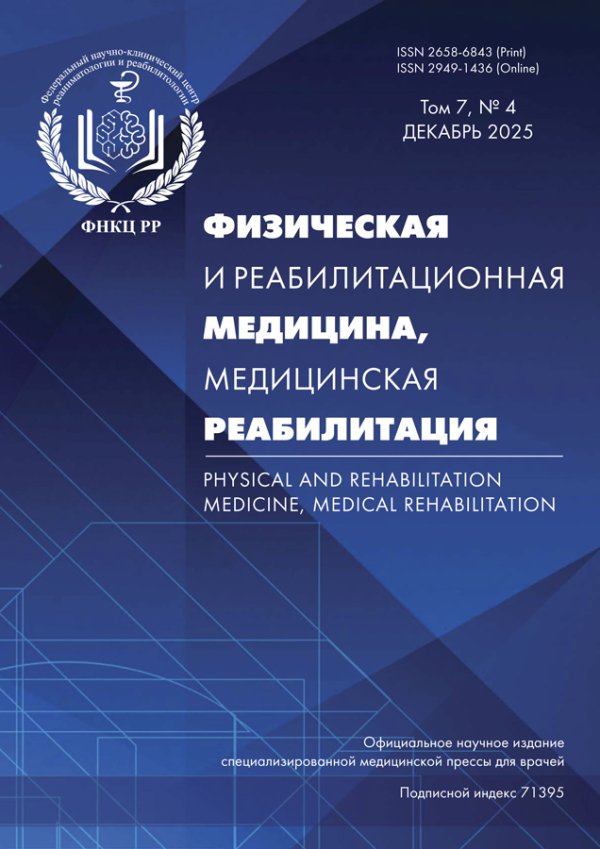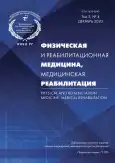The effect of virtual reality based cognitive-motor training on psychophysiological parameters and balance function in the elderly
- Authors: Khizhnikova A.E.1, Klochkov A.S.1, Kotov-Smolenskiy A.M.1, Fuks A.A.2, Suponeva N.A.1, Piradov M.A.1
-
Affiliations:
- Research Center of Neurology
- Lomonosov Moscow State University
- Issue: Vol 2, No 4 (2020)
- Pages: 292-302
- Section: ORIGINAL STUDY ARTICLE
- URL: https://journal-vniispk.ru/2658-6843/article/view/52594
- DOI: https://doi.org/10.36425/rehab52594
- ID: 52594
Cite item
Full Text
Abstract
Background. Balance dysfunction is one of the most common problems in older people. Research shows that response time to visual and auditory stimuli is an indicator of inhibition processes that play a critical role in maintaining balance in the elderly, and time reaction tests can predict the risk of falls in the elderly. One of the advantages of virtual reality technology is the ability to implement cognitive-motor training. It is considered that training in a virtual environment helps to improve the reaction to a rapid change of environment, attention, space-time memory, and planning, which has a beneficial effect on postural functions. Nevertheless, the effect of training in a virtual environment on neurodynamic processes has not been sufficiently studied.
Aims: to study the status and dynamics of psychophysiological indicators and their relationship with the balance function after cognitive-motor training in a virtual environment in patients with CCI.
Methods. The study involved 24 people. The experimental group included 14 patients with a confirmed diagnosis of chronic cerebral ischemia. A group of 10 healthy volunteers were tested on the UPFT-1/30 «Psychophysiologist» system. Patients included in the experimental group were tested using clinical scales (the Berg balance assessment scale and the MOCA scale) and instrumental assessment on UPFT-1/30 «Psychophysiologist». All patients underwent cognitive-motor training on the «Rehabunculus» virtual reality system (Russia), aimed at restoring the balance function.
Results. After the course of cognitive-motor training in a virtual environment, the patients showed a significant (p=0.01) improvement in the balance functions, assessed by the Berg Balance Scale, as well as a decrease in the number of errors and an improvement in the stability of visual-motor reaction test. In addition, a negative correlation was found between the median response time and the balance function on the Berg scale (r=-0.715).
Conclusions. The speed of reaction to a visual stimulus can serve as markers of the adaptation processes of the nervous system to cognitive-motor training in virtual environment, which, in turn, have a positive effect on balance function.
Full Text
##article.viewOnOriginalSite##About the authors
Anastasiya E. Khizhnikova
Research Center of Neurology
Email: nastushkapal@gmail.com
ORCID iD: 0000-0003-1395-6645
SPIN-code: 4824-1240
MD, PhD
Russian Federation, 80 Volokolamsk sh., 125367 MoscowAnton S. Klochkov
Research Center of Neurology
Email: klochkov@neurology.ru
ORCID iD: 0000-0002-4730-3338
SPIN-code: 3445-8770
MD, PhD
Russian Federation, MoscowArtem M. Kotov-Smolenskiy
Research Center of Neurology
Email: a.kotov.smolenskiy@gmail.com
ORCID iD: 0000-0002-2738-9939
SPIN-code: 9603-9135
Russian Federation, Moscow
Anna A. Fuks
Lomonosov Moscow State University
Email: myfannamail@gmail.com
ORCID iD: 0000-0002-4335-6344
SPIN-code: 8236-1787
Russian Federation, Moscow
Natalia A. Suponeva
Research Center of Neurology
Author for correspondence.
Email: nasu2709@mail.ru
ORCID iD: 0000-0003-3956-6362
SPIN-code: 3223-6006
Russian Federation, Moscow
Michael A. Piradov
Research Center of Neurology
Email: dir@neurology.ru
ORCID iD: 0000-0002-6338-0392
SPIN-code: 2860-1689
Russian Federation, Moscow
References
- World Health Organization. WHO Global Report on Falls Prevention in Older Age. WHO; 2007. Available from: https://www.who.int/ageing/publications/Falls_prevention7March.pdf.
- Ou LC, Chang YF, Chang CS, et al. Epidemiological survey of the feasibility of broadband ultrasound attenuation measured using calcaneal quantitative ultrasound to predict the incidence of falls in the middle aged and elderly. BMJ Open. 2017;7(1):e013420. doi: 10.1136/bmjopen-2016-013420.
- Salthouse TA. When does age-related cognitive decline begin? Neurobiol Aging. 2009;30(4):507–514. doi: 10.1016/ j.neurobiolaging.2008.09.023.
- Salthouse T. Consequences of age-related cognitive declines. Annu Rev Psychol. 2012;63(1):201–226. doi: 10.1146/ annurev-psych-120710-100328.
- Fortenbaugh FC, DeGutis J, Germine L, et al. Sustained attention across the life Span in a sample of 10,000. Psychol Science. 2015;26(9):1497–1510. doi: 10.1177/ 0956797615594896.
- Mendelson DN, Redfern MS, Nebes RD, Jennings RJ. Inhibitory processes relate differently to balance/reaction time dual tasks in young and older adults. Aging, Neuropsychol Cogn. 2009;17(1):1–18. doi: 10.1080/ 13825580902914040.
- Schoene D, Delbaere K, Lord SR. Impaired response selection during stepping predicts falls in older people — a cohort study. J Am Med Dir Assoc. 2017;18(8):719–725. doi: 10.1016/j.jamda.2017.03.010.
- Кадыков А.С., Манвелов Л.С., Шахпаронова Н.В. Хронические сосудистые заболевания головного мозга (дисциркуляторная энцефалопатия). — М.: ГЭОТАР-Мед, 2006. [Kadykov AS, Manvelov LS, Shakhparonova NV. Khronicheskie sosudistye zabolevaniya golovnogo mozga (distsirkulyatornaya ehntsefalopatiya). Moscow: GEOTAR-Med; 2006. (In Russ).]
- Kim BR, Chun MH, Kim LS, Park JY. Effect of virtual reality on cognition in stroke patients. Ann Rehabil Med. 2011;35(4):450. doi: 10.5535/arm.2011.35.4.450.
- Bisson E, Contant B, Sveistrup H, Lajoie Y. Functional balance and dual-task reaction times in older adults are improved by virtual reality and biofeedback training. Cyber Psychol Behav. 2007;10(1):16–23. doi: 10.1089/cpb.2006.9997.
- Kizony R, Levin MF, Hughey L, et al. Cognitive load and dual-task performance during locomotion poststroke: a feasibility study using a functional virtual environment. Phys Ther. 2010;90(2):252–260. doi: 10.2522/ptj.20090061.
- Kannan L, Vora J, Bhatt T, Hughes SL. Cognitive-motor exergaming for reducing fall risk in people with chronic stroke: A randomized controlled trial. NeuroRehabilitation. 2019;44(4):493–510. doi: 10.3233/NRE-182683.
- Li KZ, Roudaia E, Lussier M, et al. Benefits of cognitive dual-task training on balance performance in healthy older adults. J Gerontol Ser A Biol Sci Med Sci. 2010;65A(12): 1344–1352. doi: 10.1093/gerona/glq151.
- De Bruin E, Eggenberger P, Angst M, et al. Does multicomponent physical exercise with simultaneous cognitive training boost cognitive performance in older adults? A 6-month randomized controlled trial with a 1-year follow-up. Clin Interv Aging. 2015;10:1335–1349. doi: 10.2147/CIA.S87732.
- Subramaniam S, Wan-Ying Hui-Chan C, Bhatt T. A cognitive-balance control training paradigm using wii fit to reduce fall risk in chronic stroke survivors. J Neurol Phys Ther. 2014;38(4):216–225. doi: 10.1097/NPT.0000000000000056.
- Косачев В.Е., Талалаев А.А. Экспресс-метод оценки функционального состояния центральной нервной системы в процессе психофизиологического мониторинга персонала энергопредприятий // Известия Таганрогского государственного радиотехнического университета. — 2000. — № 4. — С. 24–26. [Kosachev VE, Talalaev AA. Ehkspress-metod otsenki funktsional’nogo sostoyaniya tsentral’noi nervnoi sistemy v protsesse psikhofiziologicheskogo monitoringa personala ehnergopredpriyatii. Izvestiya Taganrogskogo gosudarstvennogo radiotekhnicheskogo universiteta. 2000; (4):24–26. (In Russ).]
- Phu S, Vogrin S, Al Saedi A, Duque G. Balance training using virtual reality improves balance and physical performance in older adults at high risk of falls. Clin Interv Aging. 2019;14:1567–1577. doi: 10.2147/CIA.S220890.
- Sherrington C, Michaleff ZA, Fairhall N, et al. Exercise to prevent falls in older adults: An updated systematic review and meta-analysis. Br J Sports Med. 2017;51(24): 1750–1758. doi: 10.1136/bjsports-2016-096547.
- Yeşilyaprak SS, Yıldırım MŞ, Tomruk M, et al. Comparison of the effects of virtual reality-based balance exercises and conventional exercises on balance and fall risk in older adults living in nursing homes in Turkey. Physiother Theory Pract. 2016;32(3):191–201. doi: 10.3109/09593985.2015.1138009.
- Der G, Deary IJ. Age and sex differences in reaction time in adulthood: Results from the United Kingdom Health and Lifestyle Survey. Psychol Aging. 2006;21(1):62–73. doi: 10.1037/0882-7974.21.1.62.
- Eckner JT, Richardson JK, Kim H, et al. A novel clinical test of recognition reaction time in healthy adults. Psychol Assess. 2012;24(1):249–254. doi: 10.1037/a0025042.
- Wang D, Zhang J, Sun Y, et al. Evaluating the fall risk among elderly population by choice step reaction test. Clin Interv Aging. 2016;11:1075–1082. doi: 10.2147/CIA.S106606.
Supplementary files











